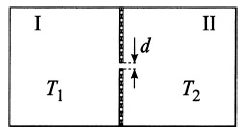
Hole in Wall
 المؤلف:
Sidney B. Cahn, Gerald D. Mahan And Boris E. Nadgorny
المؤلف:
Sidney B. Cahn, Gerald D. Mahan And Boris E. Nadgorny
 المصدر:
A GUIDE TO PHYSICS PROBLEMS
المصدر:
A GUIDE TO PHYSICS PROBLEMS
 الجزء والصفحة:
part 2 , p 11
الجزء والصفحة:
part 2 , p 11
 29-8-2016
29-8-2016
 1578
1578
Hole in Wall
A container is divided into two parts, I and II, by a partition with a small hole of diameter d. Helium gas in the two parts is held at temperatures T1 = 150 K and T2 = 300K, respectively, through heating of the walls (see Figure 1.1).

Figure 1.1
a) How does the diameter d determine the physical process by which the gases come to steady state?
b) What is the ratio of the mean free paths λ1/λ2 between the two parts when d << λ1, d << λ2?
c) What is the ratio λ1/λ2 when d >> λ1, d >> λ2?
SOLUTION
a) If the diameter of the hole is large compared to the mean free path in both gases, we have regular hydrodynamic flow of molecules in which the pressures are the same in both parts. If the diameter of the hole (and thickness of the partition) is small compared to the mean free path, there are practically no collisions within the hole and the molecules thermalize far from the hole (usually through collisions with the walls).
b) In case d << λ1, d << λ2, there are two independent effusive flows from I to II and from II to I. The number of particles N1 and N2 going through the hole from parts I and II are, respectively,
 (1)
(1)
where A = πd2/4 is the area of the hole. At equilibrium, N1 = N2, so we have
 (2)
(2)
The mean free path is related to the volume concentration of the molecules n by the formula
 (3)
(3)
where σ is the effective cross section of the molecule, which depends only on the type of molecule, helium in both halves. Substituting (3) into (2) gives

or

c) When d >> λ1, d >> λ2, we have to satisfy the condition

or

which gives for the ratio of the mean free paths:

 الاكثر قراءة في مواضيع اخرى
الاكثر قراءة في مواضيع اخرى
 اخر الاخبار
اخر الاخبار
اخبار العتبة العباسية المقدسة


